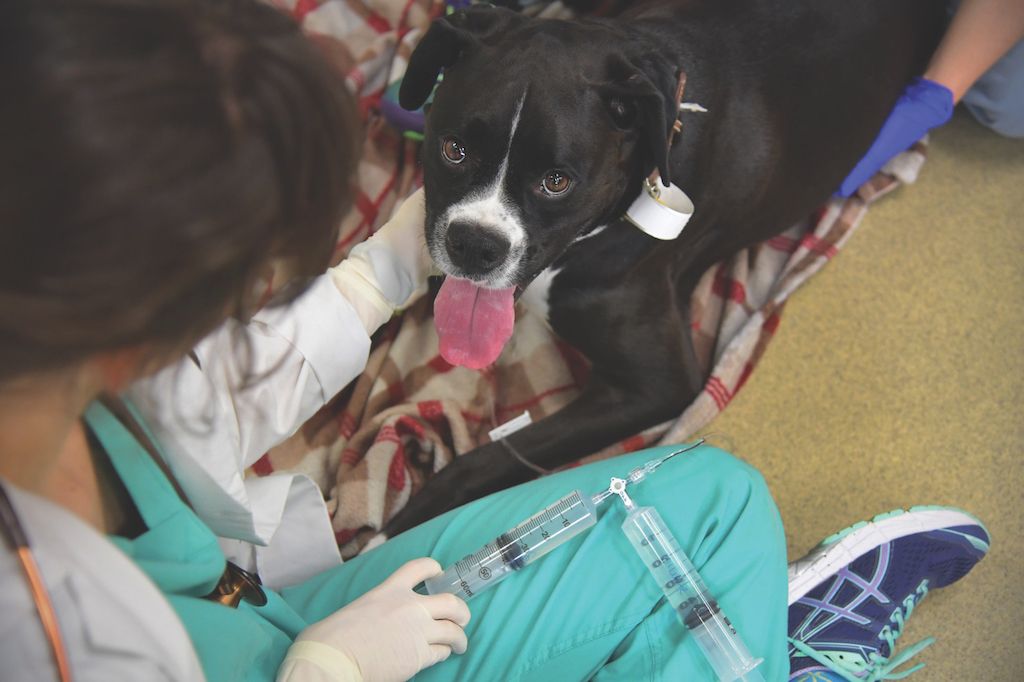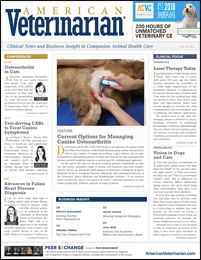ACVP 2017: Test-driving CARs to Treat Canine Lymphoma
Hope—in the form of chimeric antigen receptor T-cell therapy—is on the horizon for extended remission in dogs with hematologic B-cell malignancies.

Chimeric antigen receptor T-cell therapy is a living therapythat has intelligent sensing and response capabilities.
According to Nicola J. Mason, PhD, BVetMed, DACVIM, associate professor of medicine and pathobiology at the University of Pennsylvania School of Veterinary Medicine in Philadelphia, adoptive cell transfer (ACT) is an emerging form of cellular therapy that in its current form involves collecting, manipulating, and reinfusing the patient’s own immune cells back into the body to treat cancer. Ex vivo manipulation of these cellular products frequently includes activation and expansion of either T cells or natural killer (NK) cells and genetic modification to redirect their antigenic specificity against tumor-associated antigens. Perhaps the most impressive example of ACT in human medicine today involves the use of autologous chimeric antigen receptor (CAR) T cells to treat patients with acute lymphoblastic leukemia (ALL), chronic lymphocytic leukemia (CLL) and, more recently, non-Hodgkin lymphoma (NHL).
RELATED:
- UPDATE: Conditionally Approved Canine Lymphoma Drug Receives FDA Grant
- Primary Mediastinal Lymphoma in Dogs
Presenting at the American College of Veterinary Pathologists 2017 Annual Meeting in Vancouver, British Columbia, Canada, Dr. Mason described how canine CAR T cells are driving hope for effective treatment of lymphoma in dogs.
Canine Lymphoma
Among the most common cancers diagnosed in dogs, lymphomas display many similarities, including clinical behavior, biology, and molecular aberrancies, to NHLs that occur in humans. Although lymphoma may affect any organ in the body, multi-centric lymphoma affects the peripheral lymph nodes, spleen, liver, and bone marrow. Dogs typically present with generalized lymphadenopathy and have intermediate- to high-grade disease that is most commonly associated with malignant B cells. The most common subtype of canine NHL is diffuse large B-cell lymphoma.
Chemotherapy, the treatment of choice for most dogs with lymphoma, typically involves a doxorubicin-based, multiagent protocol. This leads to clinical remission in about 85% of dogs. Despite treatment, however, most of these dogs will relapse with lethal, drug-resistant lymphoma within 6 to 9 months of diagnosis. This suggests that our current chemotherapeutic protocols are insufficient to eliminate all neoplastic cells within the body and, as such, we routinely fail to achieve durable remission or cures with our current treatment regimens. Therefore, development of alternative treatment modalities such as immunotherapy seems to be critically important if we aim to improve on the time to progression and overall survival times in dogs with lymphoma.
What is CAR T-cell Therapy, and How Does It Work?
Over the past decade, cell-based immunotherapies have achieved unprecedented success in humans for the treatment of hematologic B-cell malignancies, including ALL, CLL, and NHL. However, their use in veterinary medicine is still in its infancy, and their effectiveness in the treatment of solid tumors has yet to be realized in either people or animals.
Most forms of ACT currently involve the use of autologous immune cells such as T cells and NK cells that have been genetically modified to redirect their antigenic specificity against malignant cells. The power of this approach is made clear by the remarkable success that CAR T cells, specific for the B-cell molecule CD19, have shown in inducing durable remission times in human patients with relapsed, refractory B-cell malignancies. Recognition of this success came last year when the FDA approved the use of CD19-targeted CAR T-cell therapy for ALL in children and young adults.
In CAR T-cell therapy, T cells are collected from the patient’s blood and genetically modified in the laboratory to express a protein receptor (CAR) on their surface that recognizes the CD19 molecule that is expressed on the surface of B cells. The CAR is introduced into the T cells using a lentiviral vector. The genetically modified CAR T cells are expanded outside the body to produce large numbers of tumor-specific T cells that can be infused back into the patient, where they will seek out CD19-positive B cells. Once the CAR engages its CD19 ligand in vivo, the T cell is activated through the intracellular T-cell signaling domain and costimulatory domains that make up the intracellular portion of the CAR. Once activated, the CAR T cells specifically kill the CD19-expressing target cells. Importantly, these cells will then go on to divide, producing 2 daughter cells, both of which also bear the CD19-targeting CAR. Thus, following administration back into the patient, the cellular product activates and expands, to the extent that up to 80% of CD8-positive T cells in the peripheral blood may express the CD19-targeting CAR. These cells will eliminate all CD19-positive cells in the body and lead to disease remission. Adoptively transferred cells will also engraft in the patient and provide long-term defense against CD19-expressing cells. Thus, these patients are usually hypoglobulinemic and show marked B-cell aplasia.
“CAR T-cell therapy is a living therapy that has intelligent sensing and response capabilities,” Dr. Mason explained, drawing the analogy with another “smart CAR,” the Tesla.
Challenges With CAR T-cell Therapy
Dr. Mason described several challenges associated with CAR T-cell therapy. Although it has shown substantial clinical benefit in humans with hematologic malignancies, CAR T-cell—based therapy still faces hurdles when directed against solid tumors. Not only is it challenging to generate these products from patients with advanced neoplastic disease because of the presence of immunosuppressive factors and intrinsic T-cell signaling defects, but it is also difficult to get these genetically redirected T cells to penetrate the solid tumor and function optimally in the immunosuppressive tumor microenvironment.
“CAR T-cell therapy is extremely potent, and it can cause significant morbidity when adoptively transferred cells are fully activated,” Dr. Mason emphasized, explaining that life-threatening cytokine release has been reported in some human patients. Massive cytokine release resulting from immune activation can manifest in various ways, ranging from fever to organ dysfunction to disseminated intravascular coagulation and death. Neurotoxicity is another concerning adverse effect that has been seen in some human patients; however, the seizures that have been reported with CAR T-cell therapy can be managed medically and appear to be transient. Dr. Mason also stressed the need to overcome adaptive resistance to CAR T-cell therapy. For example, some patients with CD19-positive B-cell leukemia who are treated with CD19-targeting CAR T cells may relapse with CD19-negative B-cell leukemia. This is because immune pressure leads to the emergence of leukemic cells that have spliced out the epitope that is recognized by the CAR T cells. This leads to patient relapse with an apparent CD19-negative leukemia.
CAR T-cell Therapy in Dogs
"Canine patients represent a parallel system to humans in which we can develop and evaluate next-generation CAR T-cell therapy,” Dr. Mason said. The progression of canine cancers more closely parallels that of human cancers than is seen in animal models of induced cancer. In particular, the biology, behavior, and genetics of some spontaneously occurring canine cancers are comparable to the characteristics of those that occur in humans. Dr. Mason’s laboratory has adapted CAR T-cell technology for use in dogs. This serves 2 purposes: to provide a model system to evaluate next-generation CAR T-cell therapies and to provide a novel and hopefully more effective therapeutic approach to providing durable remissions and cures in canine patients with B-cell malignancies.
To evaluate next-generation CAR T-cell therapies in dogs, Dr. Mason stressed the need for methods to effectively expand and genetically modify canine T cells for adoptive transfer. Her laboratory has devel- oped an in vitro system for canine T-cell expansion. This system is based on K562 cells, a human erythroleukemic cell line that has been stably transduced to express the canine costimulatory molecules that are needed to support T-cell activation.
She and her team tested the system on peripheral blood lymphocytes isolated from healthy dogs. In the absence of exogenous cytokines, this method produced a 50-fold expansion of T cells. In contrast, adding exogenous cytokines to the system dramatically enhanced T-cell proliferation, leading to a 250-fold expansion.
After collecting peripheral blood from dogs with lymphoma, the investigators used this system to expand the patients’ white blood cells in vitro and were able to produce sufficient canine T cells to perform CAR T-cell infusions.
In collaboration with investigators at The University of Texas MD Anderson Cancer Center in Houston, Dr. Mason’s laboratory developed a CD20-targeting, second-generation CAR, and they are evaluating its ability to eliminate CD20-positive B cells in dogs with B-cell leukemia and B-cell lymphoma.
According to Dr. Mason, results from early studies have indicated that CAR T-cell therapy has an effect in canine patients with B-cell malignancies. It has led to stable disease in these patients for a period of time, reversal of the ratio of B cells to T cells in the lymph nodes, and an increase in the number of cytotoxic CD8 T cells in peripheral blood as well as clear evidence of immunologic pressure against CD20. Currently, however, the therapeutic effect is transient.
Dr. Mason acknowledged that investigators have experienced problems generating CAR T cells from human and canine patients with advanced disease and discussed potential strategies to help overcome challenges. “To deal with this, we have to optimize T-cell production strategies,” she said. She also stressed the need to consider moving away from using an autologous CAR T-cell product to using a universal CAR T-cell product. “These products will obviously require further genetic modification to eliminate the T-cell receptor and major histocompatibility complex molecules to prevent graft-versus-host disease and universal CAR T-cell rejection, respectively,” she explained.
Antigen escape leading to CAR T-cell resistance is another problem to overcome in both humans and dogs, Dr. Mason noted, suggesting that adopting a dual CAR targeting approach against CD19 and CD20 would be a rational strategy to reduce adaptive resistance.
“So far, we have not seen significant adverse effects using canine CAR T cells in vivo,” she explained. “We have not appreciated any cytokine storms or neurotoxicity.” However, Dr. Mason believes that as the technology improves in dogs, some of these adverse effects will inevitably emerge. This is because as the number of CAR T cells administered increases to achieve more durable effects, it is likely that more cytokines will be produced, and these cytokines mediate the adverse effects.
Nevertheless, the stage is set for CAR T cells to enter the veterinary oncology arena, and there are high hopes that this may lead to the durable remission in canine patients with B-cell lymphoma that has so long eluded us.
Dr. Parry, a board-certified veterinary pathologist, graduated from the University of Liverpool in 1997. After 13 years in academia, she founded Midwest Veterinary Pathology, LLC, where she now works as a private consultant. Dr. Parry writes regularly for veterinary organizations and publications.
Newsletter
From exam room tips to practice management insights, get trusted veterinary news delivered straight to your inbox—subscribe to dvm360.
